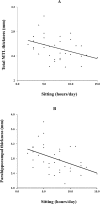Sedentary behavior associated with reduced medial temporal lobe thickness in middle-aged and older adults
- PMID: 29649304
- PMCID: PMC5896959
- DOI: 10.1371/journal.pone.0195549
Sedentary behavior associated with reduced medial temporal lobe thickness in middle-aged and older adults
Abstract
Atrophy of the medial temporal lobe (MTL) occurs with aging, resulting in impaired episodic memory. Aerobic fitness is positively correlated with total hippocampal volume, a heavily studied memory-critical region within the MTL. However, research on associations between sedentary behavior and MTL subregion integrity is limited. Here we explore associations between thickness of the MTL and its subregions (namely CA1, CA23DG, fusiform gyrus, subiculum, parahippocampal, perirhinal and entorhinal cortex,), physical activity, and sedentary behavior. We assessed 35 non-demented middle-aged and older adults (25 women, 10 men; 45-75 years) using the International Physical Activity Questionnaire for older adults, which quantifies physical activity levels in MET-equivalent units and asks about the average number of hours spent sitting per day. All participants had high resolution MRI scans performed on a Siemens Allegra 3T MRI scanner, which allows for detailed investigation of the MTL. Controlling for age, total MTL thickness correlated inversely with hours of sitting/day (r = -0.37, p = 0.03). In MTL subregion analysis, parahippocampal (r = -0.45, p = 0.007), entorhinal (r = -0.33, p = 0.05) cortical and subiculum (r = -0.36, p = .04) thicknesses correlated inversely with hours of sitting/day. No significant correlations were observed between physical activity levels and MTL thickness. Though preliminary, our results suggest that more sedentary non-demented individuals have less MTL thickness. Future studies should include longitudinal analyses and explore mechanisms, as well as the efficacy of decreasing sedentary behaviors to reverse this association.
Conflict of interest statement
Figures


References
-
- Beckett MW, Ardern CI, Rotondi M. A meta-analysis of prospective studies on the role of physical activity and the prevention of Alzheimer’s disease in older adults. BMC Geriatr. 2015;15:1–7 doi: 10.1186/1471-2318-15-1 - DOI - PMC - PubMed
-
- Larson EB, Wang L, Bowen JD, McCormick WC, Teri L, Crane P, et al. Exercise is associated with reduced risk for incident dementia among persons 65 years of age and older. Ann Intern Med. 2006;144: 73–81 - PubMed
-
- Lautenschlager NT, Cox KL, Flicker L, Foster JK, van Bockxmeer FM, Xiao J, et al. Effect of physical activity on cognitive function in older adults at risk for Alzheimer disease: a randomized trial. JAMA 2008;300: 1027–1037 doi: 10.1001/jama.300.9.1027 - DOI - PubMed
-
- Ahlskog JE, Geda YE, Graff-Radford NR, Petersen RC. Physical exercise as a preventive or disease-modifying treatment of dementia and brain aging. Mayo Clin Proc. 2011;86: 876–884 doi: 10.4065/mcp.2011.0252 - DOI - PMC - PubMed
-
- Tian Q, Erickson K, Simonsick EM, Aizenstein HJ, Glynn NW, Boudreau RM, et al. Physical activity predicts microstructural integrity in memory-related networks in very old adults. J Gerontol A Biol Sci Med Sci. 2014;69: 1284–1290 doi: 10.1093/gerona/glt287 - DOI - PMC - PubMed
Publication types
MeSH terms
Grants and funding
- P01-AG024831/NH/NIH HHS/United States
- MH/AG58156/NH/NIH HHS/United States
- P30 AG010123/AG/NIA NIH HHS/United States
- AG13308/NH/NIH HHS/United States
- R01 AG013308/AG/NIA NIH HHS/United States
- P50 AG016570/AG/NIA NIH HHS/United States
- P30 AG028748/AG/NIA NIH HHS/United States
- AT003480 /NH/NIH HHS/United States
- M01-RR00865 /NH/NIH HHS/United States
- R01 MH077650/MH/NIMH NIH HHS/United States
- MH077650/NH/NIH HHS/United States
- UL1 TR001881/TR/NCATS NIH HHS/United States
- 5P30AG028748/NH/NIH HHS/United States
- K01 DA034728/DA/NIDA NIH HHS/United States
- AG10123 /NH/NIH HHS/United States
- R21 AT003480/AT/NCCIH NIH HHS/United States
- P50 AG 16570 /NH/NIH HHS/United States
- M01 RR000865/RR/NCRR NIH HHS/United States
- UL1TR000124 /NH/NIH HHS/United States
- UL1 TR000124/TR/NCATS NIH HHS/United States
LinkOut - more resources
Full Text Sources
Other Literature Sources
Medical
Miscellaneous

